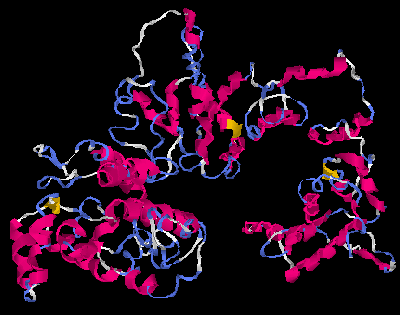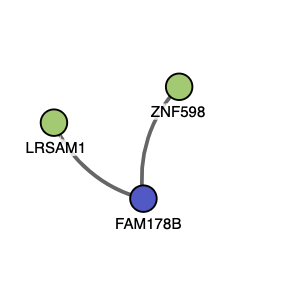FAM178B on:
[Wikipedia]
[Google]
[Amazon]
FAM178B is a protein coding gene that is located on the plus strand of chromosome 2.FAM178B - Protein FAM178B - Homo sapiens (Human) - FAM178B gene & protein. (n.d.). Retrieved February 25, 2019, from https://www.uniprot.org/uniprot/Q8IXR5 The



 The promoter region of FAM178B is highly conserved across its most related orthologs, and is almost identical across the human, gorilla, chimp, bonobo and gibbon organisms.
The promoter region of FAM178B is highly conserved across its most related orthologs, and is almost identical across the human, gorilla, chimp, bonobo and gibbon organisms.
 MENTHA interacting proteins for FAM178B.
MENTHA interacting proteins for FAM178B.
 STRING interacting proteins for FAM178B.
STRING interacting proteins for FAM178B.
locus
Locus (plural loci) is Latin for "place". It may refer to:
Mathematics and science
* Locus (mathematics), the set of points satisfying a particular condition, often forming a curve
* Root locus analysis, a diagram visualizing the position of r ...
for the gene is 2q11.2. It is also known by the aliases Family with Sequence Similarity 178, Member B, and HSPC234. In total there are 24 exons
An exon is any part of a gene that will form a part of the final mature RNA produced by that gene after introns have been removed by RNA splicing. The term ''exon'' refers to both the DNA sequence within a gene and to the corresponding sequence i ...
in the gene. FAM178B spans 110,720 base pairs, and contains 827 amino acids.
Forms
There are twoisoforms
A protein isoform, or "protein variant", is a member of a set of highly similar proteins that originate from a single gene and are the result of genetic differences. While many perform the same or similar biological roles, some isoforms have uniqu ...
of the gene transcript that exist by alternative splicing
Alternative splicing, alternative RNA splicing, or differential splicing, is an alternative RNA splicing, splicing process during gene expression that allows a single gene to produce different splice variants. For example, some exons of a gene ma ...
, and one gene precursor.
SLF2 (FAM178A) is an important paralog
Sequence homology is the biological homology between DNA, RNA, or protein sequences, defined in terms of shared ancestry in the evolutionary history of life. Two segments of DNA can have shared ancestry because of three phenomena: either a sp ...
of FAM178B. SLF2 is predicted to play a role in the DNA damage response (DDR) pathway by regulating post-replication repair of UV-damaged DNA, and genomic stability maintenance.
Protein structure
Themolecular weight
A molecule is a group of two or more atoms that are held together by Force, attractive forces known as chemical bonds; depending on context, the term may or may not include ions that satisfy this criterion. In quantum physics, organic chemi ...
of the protein is 76.5 kilodaltons, and the isoelectric point
The isoelectric point (pI, pH(I), IEP), is the pH at which a molecule carries no net electric charge, electrical charge or is electrically neutral in the statistical mean. The standard nomenclature to represent the isoelectric point is pH(I). Howe ...
is 5.47.The gene has 6 transcript splice variants. The protein has been phenotypically associated with bipolar disease due to its locus, as well as body mass index
Body mass index (BMI) is a value derived from the mass (Mass versus weight, weight) and height of a person. The BMI is defined as the human body weight, body mass divided by the square (algebra), square of the human height, body height, and is ...
(BMI), and cell adhesion
Cell adhesion is the process by which cells interact and attach to neighbouring cells through specialised molecules of the cell surface. This process can occur either through direct contact between cell surfaces such as Cell_junction, cell junc ...
. A proposed structure for the protein can be found in the images for proposed structures. The secondary structure
Protein secondary structure is the local spatial conformation of the polypeptide backbone excluding the side chains. The two most common Protein structure#Secondary structure, secondary structural elements are alpha helix, alpha helices and beta ...
for the FAM178B protein is predicted to be primarily alpha helices. The tertiary structure
Protein tertiary structure is the three-dimensional shape of a protein. The tertiary structure will have a single polypeptide chain "backbone" with one or more protein secondary structures, the protein domains. Amino acid side chains and the ...
of the protein may assume a coiled coil structure.

Expression
FAM178B is most highly expressed in theskeletal muscle
Skeletal muscle (commonly referred to as muscle) is one of the three types of vertebrate muscle tissue, the others being cardiac muscle and smooth muscle. They are part of the somatic nervous system, voluntary muscular system and typically are a ...
and brain tissues.The structure in which it is highly concentrated is in the corpus callosum
The corpus callosum (Latin for "tough body"), also callosal commissure, is a wide, thick nerve tract, consisting of a flat bundle of commissural fibers, beneath the cerebral cortex in the brain. The corpus callosum is only found in placental ...
of the brain. Additionally, it is of high levels in the trigeminal nerve
In neuroanatomy, the trigeminal nerve (literal translation, lit. ''triplet'' nerve), also known as the fifth cranial nerve, cranial nerve V, or simply CN V, is a cranial nerve responsible for Sense, sensation in the face and motor functions ...
and spinal cord. Further, there is also high concentrations of the gene found near the heart, testes and olfactory regions.
According to the Allen Brain Atlas
The Allen Mouse and Human Brain Atlases are projects within the Allen Institute for Brain Science which seek to combine genomics with neuroanatomy by creating gene expression maps for the mouse and human brain. They were initiated in September 20 ...
, the olfactory regions, and the hippocampus
The hippocampus (: hippocampi; via Latin from Ancient Greek, Greek , 'seahorse'), also hippocampus proper, is a major component of the brain of humans and many other vertebrates. In the human brain the hippocampus, the dentate gyrus, and the ...
of the mouse brain showed the greatest expressions of the gene when tested experimentally.

DNA Level Regulation
The proposed promoter region of FAM178B protein is below. A table of relevant transcription factor binding sites that correspond to the sequence and colors highlighted in the promoter region is also included.
 The promoter region of FAM178B is highly conserved across its most related orthologs, and is almost identical across the human, gorilla, chimp, bonobo and gibbon organisms.
The promoter region of FAM178B is highly conserved across its most related orthologs, and is almost identical across the human, gorilla, chimp, bonobo and gibbon organisms.
Protein Level Regulation
Below is a table that shows the protein modifications that could be potentially made to FAM178B, and the potential effects of these modifications on the protein itself:.Homology and Evolution
An important paralog of the gene is SLF2, which plays a role in the DNA damage response (DDR) pathway by regulating post replication repair of UV-damaged DNA. It also helps maintain genomic stability. There are 74 knownorthologs
Sequence homology is the biological homology between DNA, RNA, or protein sequences, defined in terms of shared ancestry in the evolutionary history of life. Two segments of DNA can have shared ancestry because of three phenomena: either a spec ...
of the protein, and it can be traced back as far back as crustaceans. FAM178B is heavily found in both vertebrates and invertebrates. The ortholog space for the protein FAM178B is quite large as it can be traced back 794 millions of years ago (mya) to mollusks with the apple snail, and Pacific Oyster. There are 134 known orthologs of FAM178B. However, the protein is not found in arthropods, or insects, which is interesting because those organisms also existed in that time period meaning that it was conserved across some taxa, but not others. The protein is most readily found in primates, and other non-primate mammals. The protein is also conserved across reptiles, some bony fish, and cartilaginous fish, and birds.
Below is a table illustrating some of the orthologs for FAM178B using BLAST
Blast or The Blast may refer to:
*Explosion, a rapid increase in volume and release of energy in an extreme manner
*Detonation, an exothermic front accelerating through a medium that eventually drives a shock front
*A planned explosion in a mine, ...
and BLAT.
Timetree for FAM178B Interacting Proteins
There are 2 proteins that have high predicted values of interaction with FAM178B: LRSAM 1 and ZNF598.LRSAM1
E3 ubiquitin-protein ligase LRSAM1, previously known as Tsg101-associated ligase (Tal), is an enzyme that in humans is encoded by the ''LRSAM1'' gene.
Clinical significance
Mutations in ''LRSAM1'' have been reported in the peripheral neuropath ...
is also known as leucine rich repeat and sterile alpha motif protein 1. The value for the protein is .29 and the evidence is physical from hybrid pooling approaches. LRSAM1 was previously known as Tsg-associated ligase and is located on the LRSAM1 gene. Mutations have been associated with periphery neuropathy, and sensory disorders. It is highly expressed in the spinal cord, as is FAM178B. There is currently no known structure for the protein. ZNF598 is a zinc finger protein and the value is .13. It plays a key role in ribosome quality control. The predicted structures are below for both proteins.
 MENTHA interacting proteins for FAM178B.
MENTHA interacting proteins for FAM178B.
 STRING interacting proteins for FAM178B.
STRING interacting proteins for FAM178B.
References
Further reading
# # {{Cite journal, last1=Stelzl, first1=Ulrich, last2=Worm, first2=Uwe, last3=Lalowski, first3=Maciej, last4=Haenig, first4=Christian, last5=Brembeck, first5=Felix H., last6=Goehler, first6=Heike, last7=Stroedicke, first7=Martin, last8=Zenkner, first8=Martina, last9=Schoenherr, first9=Anke, date=2005-09-23, title=A human protein-protein interaction network: a resource for annotating the proteome, url=https://www.ncbi.nlm.nih.gov/pubmed?cmd=search&term=16169070&dopt=b, journal=Cell, volume=122, issue=6, pages=957–968, doi=10.1016/j.cell.2005.08.029, issn=0092-8674, pmid=16169070, hdl=11858/00-001M-0000-0010-8592-0, s2cid=8235923, hdl-access=free # Cloning and functional analysis of cDNAs with open reading frames for 300 previously undefined genes expressed in CD34+ hematopoietic stem/progenitor cells Protein classification